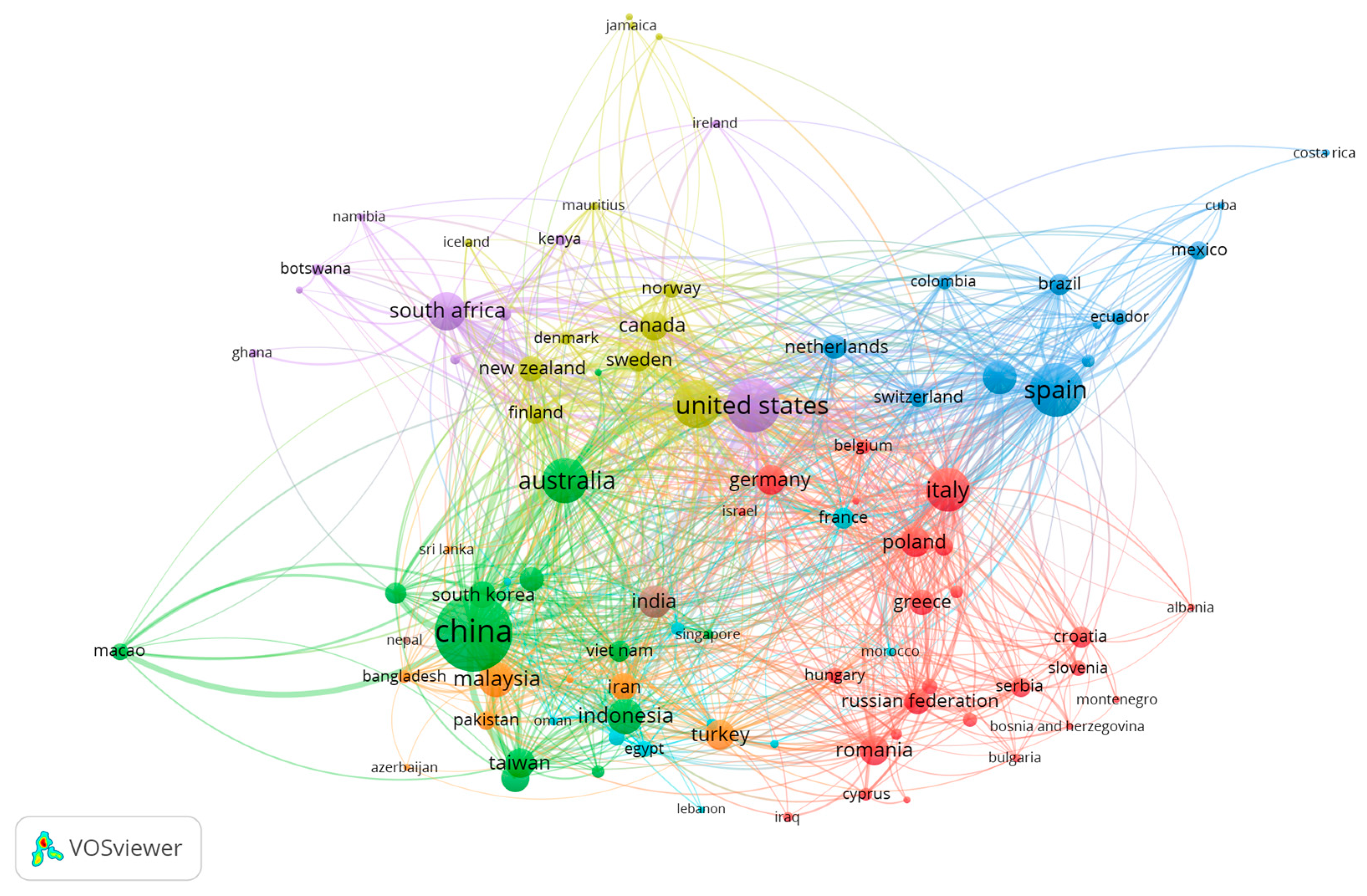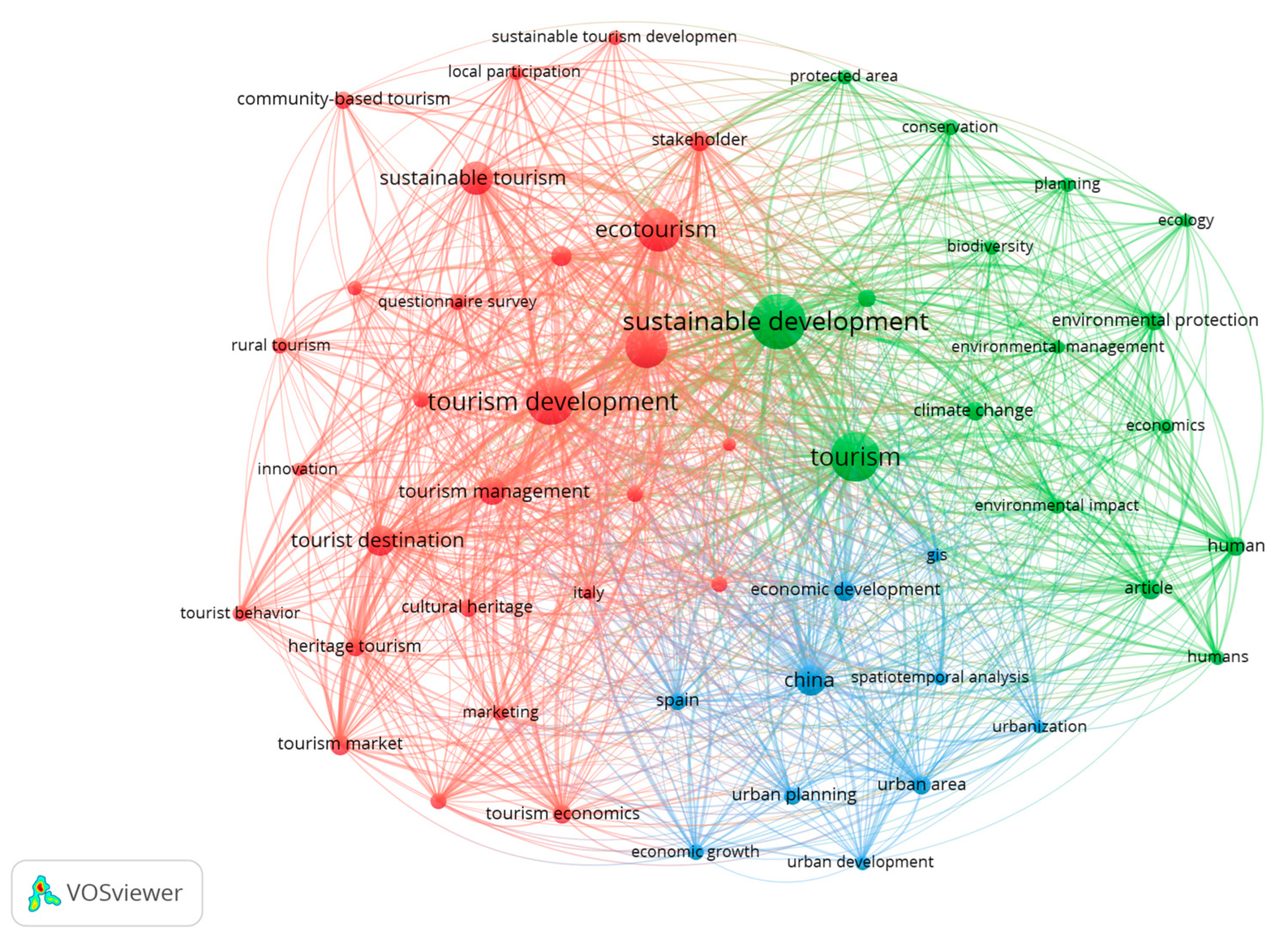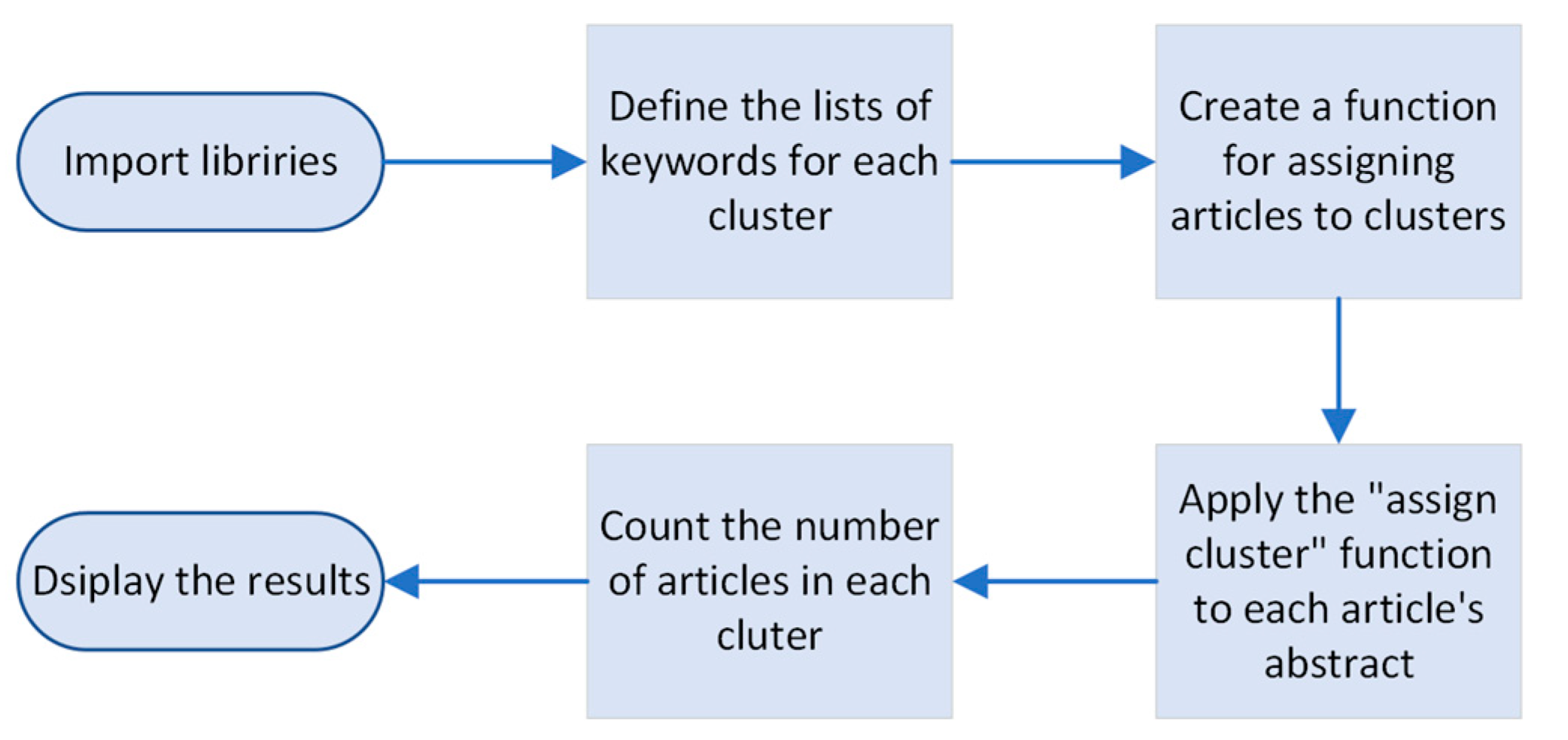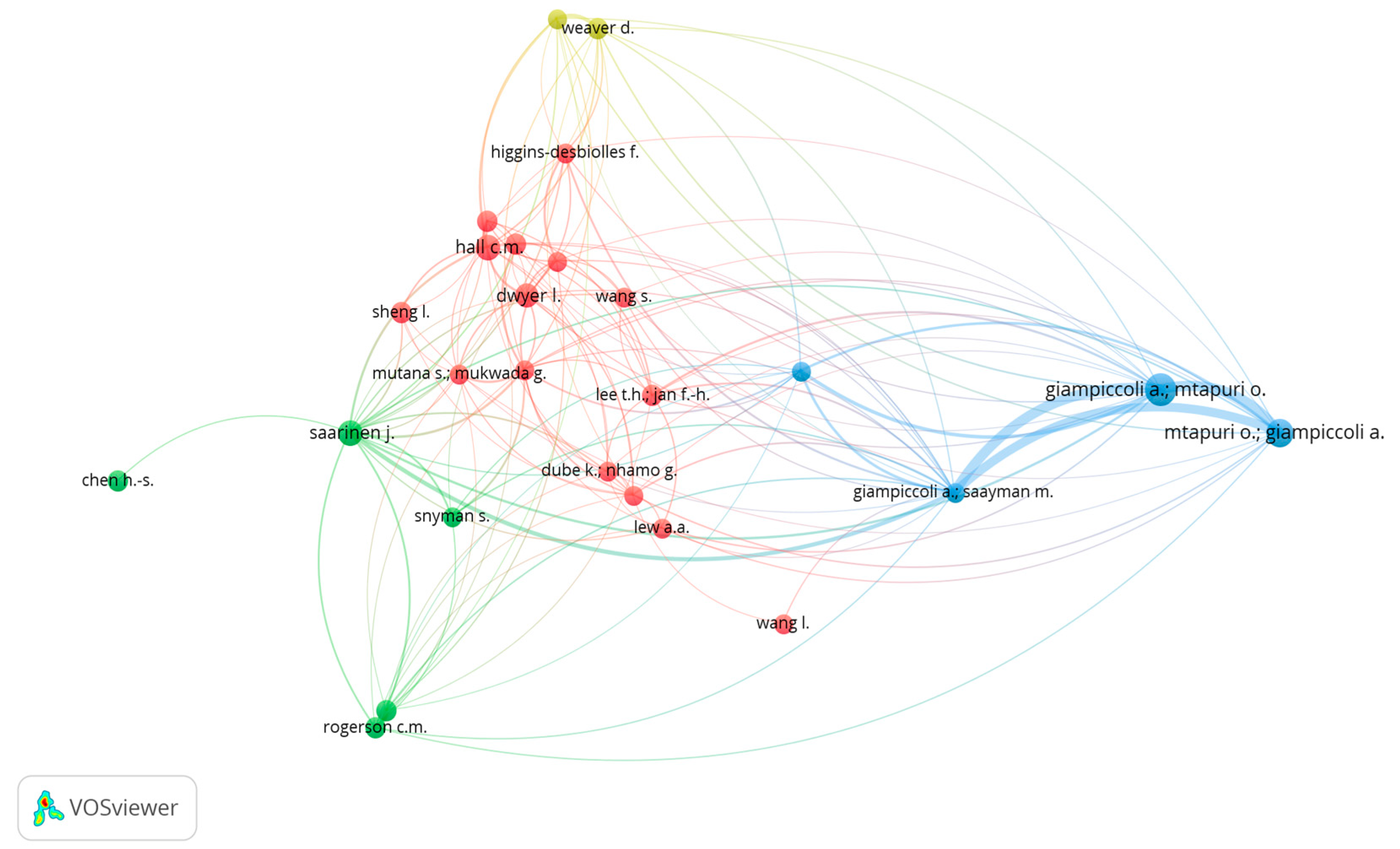A Bibliometric Analysis of Integrating Tourism Development into Urban Planning
Abstract
:1. Introduction
- What are the key trends and themes in tourism and urban planning research, as indicated by the top-cited documents and authors in the Scopus dataset?
- How do co-authorship patterns among countries reflect collaborations in the field of tourism and urban planning, and what are the implications for international research networks and partnerships?
- What are the major research clusters and thematic areas in the co-occurrence analysis of keywords, and how do these clusters contribute to our understanding of sustainable tourism development, environmental conservation, and urban growth?
- How does co-citation analysis shed light on the most influential authors in the field, and what does it tell us about the intellectual foundations and knowledge dissemination in tourism and urban planning research?
2. Methodology and Data
2.1. Dataset
2.2. Citation Analysis
2.3. Co-Authorship Analysis
2.4. Co-Occurence Analysis
2.5. Bibliographic Coupling Analysis
2.6. Co-Citation Analysis
3. Results
3.1. Results of Citation Analysis
3.2. Results of Co-Authorship Analysis
3.2.1. Co-Authorship Analysis Using VOSviewer
3.2.2. Deeper Co-Authorship Analysis Using Python
3.3. Results of Co-Occurrence Analysis
3.4. Results of Bibliographic Coupling Analysis
3.5. Results of Co-Citation Analysis
4. Conclusions
5. Future Direction
Author Contributions
Funding
Informed Consent Statement
Data Availability Statement
Conflicts of Interest
Appendix A
| import pandas as pd import numpy as np from sklearn.feature_extraction.text import CountVectorizer import nltk from nltk.corpus import wordnet import nltk nltk.download(‘wordnet’) # Define clusters as lists cluster1 = [“Albania”,”Austria”,”Belgium”,”Bosnia_and_Herzegovina”,”Bulgaria”,”Croatia”,”Cyprus”,”Czechia”,”Germany”,”Estonia”,”Greece”,”Hungary”,”Italy”,”Iraq”,”Israel”,”Latvia”,”Kazakhstan”,”Lithuania”,”Montenegro”,”Romania”,”Poland”,”Russia”,”Serbia”,”Slovakia”,”Slovenia”,”Ukraine”] cluster2 = [“Australia”,”China”,”Fiji”,”Hong_Kong”,”Indonesia”,”Japan”,”Philippines”,”Singapore”,”South_Korea”,”Taiwan”,”Thailand”,”Vietnam”] cluster3 = [“Argentina”,”Brazil”,”Chile”,”Colombia”,”Costa_Rica”,”Cuba”,”Mexico”,”Ecuador”,”Netherlands”,”Peru”,”Spain”,”Portugal”,”Switzerland”] cluster4 = [“Denmark”,”Canada”,”Iceland”,”Finland”,”Jamaica”,”Malta”,”Mauritius”,”New_Zealand”,”Norway”,”Sweden”,”Trinidad_and_Tobago”,”United_Kingdom”] cluster5 = [“Botswana”,”Ghana”,”Ireland”,”Kenya”,”Namibia”,”South_Africa”,”Nigeria”,”Tanzania”,”United_States”,”Zimbabwe”] cluster6 = [“Egypt”,”Algeria”,”France”,”Jordan”,”Morocco”,”Lebanon”,”Oman”,”Qatar”,”Saudi_Arabia”,”United_Arab_Emirates”] cluster7 = [“Azerbaijan”,”Iran”,”Bangladesh”,”Pakistan”,”Malaysia”,”Sri_Lanka”,”TOΦrkiye”,”Uzbekistan”] cluster8 = [“India”, “Ethiopia”, “Nepal”] # Define a function to extract the country from the affiliation def extract_country(affiliation): if pd.isna(affiliation): return “Unknown” for country in cluster1: if country in affiliation: return country for country in cluster2: if country in affiliation: return country for country in cluster3: if country in affiliation: return country for country in cluster4: if country in affiliation: return country for country in cluster5: if country in affiliation: return country for country in cluster6: if country in affiliation: return country for country in cluster7: if country in affiliation: return country for country in cluster8: if country in affiliation: return country return “Unknown” # Apply the function to create the “Country” column df[‘Country’] = df[‘Affiliations’].apply(extract_country) # Define clusters based on countries clusters = { “Cluster 1”: df[df[‘Country’].apply(lambda x: x in cluster1)], “Cluster 2”: df[df[‘Country’].apply(lambda x: x in cluster2)], “Cluster 3”: df[df[‘Country’].apply(lambda x: x in cluster3)], “Cluster 4”: df[df[‘Country’].apply(lambda x: x in cluster4)], “Cluster 5”: df[df[‘Country’].apply(lambda x: x in cluster5)], “Cluster 6”: df[df[‘Country’].apply(lambda x: x in cluster6)], “Cluster 7”: df[df[‘Country’].apply(lambda x: x in cluster7)], “Cluster 8”: df[df[‘Country’].apply(lambda x: x in cluster8)], } # Function to extract keywords from a text def extract_keywords(text, num_keywords=10): # Define a CountVectorizer for text analysis vectorizer = CountVectorizer() # Convert the text to vectors X = vectorizer.fit_transform([text]) # Calculate the sum of word frequencies word_freq = list(zip(vectorizer.get_feature_names_out(), X.sum(axis=0).tolist()[0])) # Sort keywords by frequency and select the top ones sorted_word_freq = sorted(word_freq, key=lambda x: x [1], reverse=True) top_keywords = [word[0] for word in sorted_word_freq[:num_keywords]] return top_keywords # Function to check if a word is a noun def is_noun(word): # Use WordNet to determine the word’s part of speech synsets = wordnet.synsets(word) for synset in synsets: if synset.pos() == ‘n’: # ‘n’ means noun return True return False # Function to extract keywords from articles in a cluster def extract_keywords_from_articles(articles, num_keywords=50): all_keywords = [] corpus = articles[‘Title’] + ‘ ‘ + articles[‘Abstract’] + ‘ ‘ + articles[‘Author Keywords’] + ‘ ‘ + articles[‘Index Keywords’] # Replace NaN values with an empty string corpus = corpus.fillna(‘‘) vectorizer = CountVectorizer() X = vectorizer.fit_transform(corpus) word_freq = list(zip(vectorizer.get_feature_names_out(), X.sum(axis=0).tolist()[0])) sorted_word_freq = sorted(word_freq, key=lambda x: x[1], reverse=True) # Filter results to include only nouns noun_keywords = [word[0] for word in sorted_word_freq if is_noun(word[0])] # Select the top noun keywords top_noun_keywords = noun_keywords[:num_keywords] return top_noun_keywords # Call the function to extract the top keywords per cluster result = {} for cluster, articles in clusters.items(): keywords = extract_keywords_from_articles(articles) result[cluster] = keywords # Print the top keywords per cluster for cluster, keywords in result.items(): print(f”Cluster: {cluster}”) print(f”Keywords: {‘, ‘.join(keywords)}”) print() |
Appendix B
| # Define the lists of keywords for each cluster cluster1_keywords = [“Community-based tourism”, “sustainable tourism”, “sustainable tourism development”, “COVID-19”, “local participation”, “stakeholder”, “innovation”, “strategic approach”, “marketing”, “perception”] cluster2_keywords = [“biodiversity”, “climate change”, “conservation”, “environmental impact”, “sustainable development”, “tourism”, “protected area”, “decision making”, “planning”] cluster3_keywords = [“economic development”, “economic growth”, “urban planning”, “urbanization”, “spatiotemporal analysis”, “GIS”, “China”, “Spain”] # Create a function for assigning articles to clusters def assign_cluster(article_text): if any(keyword in article_text for keyword in cluster1_keywords): return “Cluster 1 (Sustainable Tourism Development and Governance Approaches)” elif any(keyword in article_text for keyword in cluster2_keywords): return “Cluster 2 (Environmental Conservation and Sustainable Tourism)” elif any(keyword in article_text for keyword in cluster3_keywords): return “Cluster 3 (Urban Development and Economic Growth)” else: return “Uncategorized” # Apply the function to each article and count the clusters data[‘Cluster’] = data[‘Abstract’].apply(assign_cluster) cluster_counts = data[‘Cluster’].value_counts() # Display the results for cluster, count in cluster_counts.items(): print(f”{cluster}: {count} articles”) |
References
- Braun, E.; Kavaratzis, M.; Zenker, S. My city—My brand: The different roles of residents in place branding. J. Place Manag. Dev. 2013, 6, 18–28. [Google Scholar] [CrossRef]
- Krabokoukis, T. Exploring the State of Research on Tourism Sustainability: A Bibliometric Analysis in the Post-COVID Era. Highlights Sustain. 2023, 2, 50–61. [Google Scholar] [CrossRef]
- Santos-Rojo, C.; Llopis-Amorós, M.; García-García, J.M. Overtourism and sustainability: A bibliometric study (2018–2021). Technol. Forecast. Soc. Chang. 2023, 188, 122285. [Google Scholar] [CrossRef]
- Sánchez-Camacho, C.; Carranza, R.; Martín-Consuegra, D.; Díaz, E. Evolution, trends and future research lines in corporate social responsibility and tourism: A bibliometric analysis and science mapping. Sustain. Dev. 2022, 30, 462–476. [Google Scholar] [CrossRef]
- Pahrudin, P.; Liu, L.-W.; Li, S.-Y. What Is the Role of Tourism Management and Marketing toward Sustainable Tourism? A Bibliometric Analysis Approach. Sustainability 2022, 14, 4226. [Google Scholar] [CrossRef]
- Serrano, L.; Sianes, A.; Ariza-Montes, A. Using Bibliometric Methods to Shed Light on the Concept of Sustainable Tourism. Sustainability 2019, 11, 6964. [Google Scholar] [CrossRef]
- Polyzos, S. Urban Development, 2nd ed.; Kritiki Publishing: Athens, Greece, 2023. [Google Scholar]
- Cracolici, M.F.; Nijkamp, P. The attractiveness and competitiveness of tourist destinations: A study of Southern Italian regions. Tour. Manag. 2009, 30, 336–344. [Google Scholar] [CrossRef]
- Seguí-Amortegui, L.; Clemente-Almendros, J.A.; Medina, R.; Gala, M.G. Sustainability and Competitiveness in the Tourism Industry and Tourist Destinations: A Bibliometric Study. Sustainability 2019, 11, 6351. [Google Scholar] [CrossRef]
- Madzík, P.; Falát, L.; Copuš, L.; Valeri, M. Digital transformation in tourism: Bibliometric literature review based on machine learning approach. Eur. J. Innov. Manag. 2023, 26, 177–205. [Google Scholar] [CrossRef]
- Gössling, S. Technology, ICT and tourism: From big data to the big picture. J. Sustain. Tour. 2021, 29, 849–858. [Google Scholar] [CrossRef]
- Buhalis, D.; O’connor, P.; Leung, R. Smart hospitality: From smart cities and smart tourism towards agile business ecosystems in networked destinations. Int. J. Contemp. Hosp. Manag. 2023, 35, 369–393. [Google Scholar] [CrossRef]
- Sun, Y.; Song, H.; Jara, A.J.; Bie, R. Internet of Things and Big Data Analytics for Smart and Connected Communities. IEEE Access 2016, 4, 766–773. [Google Scholar] [CrossRef]
- Jarneving, B. Bibliographic coupling and its application to research-front and other core documents. J. Informetr. 2007, 1, 287–307. [Google Scholar] [CrossRef]
- Raymond, C.M.; Fazey, I.; Reed, M.S.; Stringer, L.C.; Robinson, G.M.; Evely, A.C. Integrating local and scientific knowledge for environmental management. J. Environ. Manag. 2010, 91, 1766–1777. [Google Scholar] [CrossRef] [PubMed]
- Jendritzky, G.; de Dear, R.; Havenith, G. UTCI—Why another thermal index? Int. J. Biometeorol. 2012, 56, 421–428. [Google Scholar] [CrossRef]
- Lee, T.H. Influence analysis of community resident support for sustainable tourism development. Tour. Manag. 2013, 34, 37–46. [Google Scholar] [CrossRef]
- D’Amato, D.; Droste, N.; Allen, B.; Kettunen, M.; Lähtinen, K.; Korhonen, J.; Leskinen, P.; Matthies, B.D.; Toppinen, A. Green, circular, bio economy: A comparative analysis of sustainability avenues. J. Clean. Prod. 2017, 168, 716–734. [Google Scholar] [CrossRef]
- Koens, K.; Postma, A.; Papp, B. Is Overtourism Overused? Understanding the Impact of Tourism in a City Context. Sustainability 2018, 10, 4384. [Google Scholar] [CrossRef]
- Gretzel, U.; Werthner, H.; Koo, C.; Lamsfus, C. Conceptual foundations for understanding smart tourism ecosystems. Comput. Hum. Behav. 2015, 50, 558–563. [Google Scholar] [CrossRef]
- Ibn-Mohammed, T.; Mustapha, K.B.; Godsell, J.; Adamu, Z.; Babatunde, K.A.; Akintade, D.D.; Acquaye, A.; Fujii, H.; Ndiaye, M.M.; Yamoah, F.A.; et al. A critical analysis of the impacts of COVID-19 on the global economy and ecosystems and opportunities for circular economy strategies. Resour. Conserv. Recycl. 2021, 164, 105169. [Google Scholar] [CrossRef]
- Scheyvens, R.; Banks, G.; Hughes, E. The Private Sector and the SDGs: The Need to Move Beyond ‘Business as Usual’: The Private Sector and the SDGs: Moving Beyond ‘Business-as-Usual’. Sustain. Dev. 2016, 24, 371–382. [Google Scholar] [CrossRef]
- Stylidis, D.; Biran, A.; Sit, J.; Szivas, E.M. Residents’ support for tourism development: The role of residents’ place image and perceived tourism impacts. Tour. Manag. 2014, 45, 260–274. [Google Scholar] [CrossRef]







| Database: | Scopus |
|---|---|
| Search field: | Title, Abstract, Keywords |
| Keywords: | Sustainable tourism development, urban planning, urban competitiveness, smart cities, community-based, tourism impacts on tourism areas, policy and governance for sustainable tourism, stakeholder and engagement in urban tourism |
| Open access: | All |
| Years: | 2010–2024 |
| Author name: | All |
| Subject area: | All |
| Publication stage: | All |
| Document type: | Article |
| Source title: | All |
| Affiliation: | All |
| Funding sponsor: | All |
| Country: | All |
| Source type: | Journal |
| Language: | English |
| Search string: | (TITLE-ABS-KEY (sustainable AND tourism AND development) OR TITLE-ABS-KEY (urban AND planning AND tourism) OR TITLE-ABS-KEY (urban AND competitiveness AND in AND tourism) OR TITLE-ABS-KEY (smart AND cities AND tourism) OR TITLE-ABS-KEY (community-based AND tourism) OR TITLE-ABS-KEY (tourism AND impacts AND on AND urban AND areas) OR TITLE-ABS-KEY (policy AND governance AND for AND sustainable AND tourism) OR TITLE-ABS-KEY (stakeholder AND engagement AND in AND urban AND tourism)) AND PUBYEAR > 2009 AND PUBYEAR < 2025 AND (LIMIT-TO (DOCTYPE, “ar”)) AND (LIMIT-TO (LANGUAGE, “English”)) AND (LIMIT-TO (SRCTYPE, “j”)) |
| Data extracted: | 11 September 2023 |
| Number of publications: | 11,134 |
| No. | Ref. | Title | Citations |
|---|---|---|---|
| 1 | [15] | Integrating local and scientific knowledge for environmental management | 725 |
| 2 | [13] | Internet of Things and Big Data Analytics for Smart and Connected Communities | 640 |
| 3 | [16] | UTCI-Why another thermal index? | 607 |
| 4 | [17] | Influence analysis of community resident support for sustainable tourism development | 570 |
| 5 | [18] | Green, circular, bio economy: A comparative analysis of sustainability avenues | 534 |
| 6 | [19] | Is overtourism overused? Understanding the impact of tourism in a city context | 415 |
| 7 | [20] | Conceptual foundations for understanding smart tourism ecosystems | 413 |
| 8 | [21] | A critical review of the impacts of COVID-19 on the global economy and ecosystems and opportunities for circular economy strategies | 390 |
| 9 | [22] | The Private Sector and the SDGs: The Need to Move Beyond ‘Business as Usual’ | 381 |
| 10 | [23] | Residents’ support for tourism development: The role of residents’ place image and perceived tourism impacts | 376 |
| No. | Author | Number of Documents | No. | Country | Number of Documents | No. | Journal | Number of Documents |
|---|---|---|---|---|---|---|---|---|
| 1 | Giampiccoli, A. | 49 | 1 | China | 1939 | 1 | Sustainability | 1347 |
| 2 | Hall, C.M. | 34 | 2 | USA | 928 | 2 | Journal of sustainable tourism | 505 |
| 3 | Mtapuri, O. | 30 | 3 | Spain | 922 | 3 | African journal of hospitality tourism and leisure | 185 |
| 4 | Castanho, R.A. | 24 | 4 | United Kingdom | 773 | 4 | Wit transactions on ecology and the environment | 157 |
| 5 | Saarinen, J. | 22 | 5 | Australia | 649 | 5 | Worldwide hospitality and tourism themes | 150 |
| 6 | Han, H. | 20 | 6 | Italy | 615 | 6 | Goejournal of tourism and geosites | 145 |
| 7 | Boley, B.B. | 19 | 7 | South Africa | 463 | 7 | Tourism management | 145 |
| 8 | Couto, G. | 18 | 8 | Malaysia | 412 | 8 | Current issues in tourism | 134 |
| 9 | Law, R. | 18 | 9 | Indonesia | 395 | 9 | Land | 133 |
| 10 | Gössling, S. | 17 | 10 | Portugal | 376 | 10 | Journal of cleaner production | 123 |
| Cluster | Cluster Title | Extracted Keywords |
|---|---|---|
| Cluster 1 | European perspective | tourism, development, study, management, tourist, sustainability, analysis, local, research, area, areas, heritage, planning, destination, social, results, approach, paper, use, ecotourism, impact, natural, model, tourists, data, authors, water, region, landscape, land, community, environment, activities, energy, policy, case, city |
| Cluster 2 | Asia–Pacific | tourism, development, study, china, analysis, management, tourist, research, model, sustainability, community, ecotourism, industry, results, area, social, local, environment, data, tourists, carbon, planning, areas, heritage, impact, system, conservation, resources, destination, paper, city, factors, water, land, use, value, method, quality, approach, ecosystem |
| Cluster 3 | Spanish-speaking regions | tourism, development, management, sustainability, tourist, analysis, study, social, spain, water, areas, destination, local, research, planning, area, heritage, community, results, impact, model, approach, use, can, paper, ecotourism, change, natural, destinations, conservation, policy, case, city, activities, ecosystem, growth, data, authors |
| Cluster 4 | Regions known for environmental consciousness | tourism, development, sustainability, management, study, local, community, an, social, planning, research, ecotourism, nature, conservation, tourist, change, use, policy, destination, climate, paper, analysis, areas, approach, land, industry, taylor, communities, tourists, results, group, impact, was, impacts, national, area, case, limited |
| Cluster 5 | African context | tourism, development, conservation, community, management, ecotourism, wildlife, study, local, natural, resource, botswana, communities, policy, sustainability, approach, benefits, areas, data, national, use, nature, energy, tourist, resources, analysis, social, area, climate, park, change, paper, planning, ecosystem, hunting, namibia, using, activities, africa |
| Cluster 6 | Middle East and North Africa | tourism, development, heritage, study, analysis, management, area, sustainability, egypt, tourist, research, planning, areas, social, local, ecotourism, land, approach, case, community, site, natural, model, sites, water, energy, paper, growth, use, cities, industry, results, conservation, policy, change, system, algeria, city |
| Cluster 7 | Eurasian and South Asian Group | tourism, development, study, malaysia, ecotourism, management, sustainability, iran, analysis, social, using, model, local, results, area, heritage, planning, water, community, growth, research, tourist, conservation, carbon, data, use, areas, land, approach, tourists, energy, environment, method, system, decision, quality, natural, industry, impact, criteria |
| Cluster 8 | South Asian | tourism, development, study, india, ecotourism, conservation, analysis, management, local, sustainability, land, community, research, area, data, water, tourist, natural, use, model, using, heritage, tourists, areas, nature, assessment, change, impact, environment, quality, approach, planning, region, city, livelihood, potential, activities, resources, ecosystem |
| Cluster | Number of Papers |
|---|---|
| 1 | 4640 |
| 2 | 6157 |
| 3 | 67 |
| Uncategorized | 270 |
| Total | 11,134 |
Disclaimer/Publisher’s Note: The statements, opinions and data contained in all publications are solely those of the individual author(s) and contributor(s) and not of MDPI and/or the editor(s). MDPI and/or the editor(s) disclaim responsibility for any injury to people or property resulting from any ideas, methods, instructions or products referred to in the content. |
© 2023 by the authors. Licensee MDPI, Basel, Switzerland. This article is an open access article distributed under the terms and conditions of the Creative Commons Attribution (CC BY) license (https://creativecommons.org/licenses/by/4.0/).
Share and Cite
Krabokoukis, T.; Polyzos, S. A Bibliometric Analysis of Integrating Tourism Development into Urban Planning. Sustainability 2023, 15, 14886. https://doi.org/10.3390/su152014886
Krabokoukis T, Polyzos S. A Bibliometric Analysis of Integrating Tourism Development into Urban Planning. Sustainability. 2023; 15(20):14886. https://doi.org/10.3390/su152014886
Chicago/Turabian StyleKrabokoukis, Thomas, and Serafeim Polyzos. 2023. "A Bibliometric Analysis of Integrating Tourism Development into Urban Planning" Sustainability 15, no. 20: 14886. https://doi.org/10.3390/su152014886






